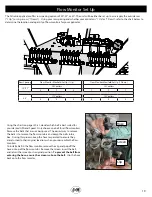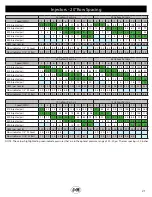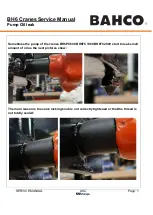
13
IMPORTANT - Before putting the applicator into operation, check the machine for damaged or worn parts and
replace as necessary.
Wheel Nuts Tightened
During initial operation, tighten standard 3/4” wheel studs and nuts to torque 400 ft-lbs. Re-check wheel nut torque settings during
initial break in period (10, 20, 50 acres), then every 10 hours of use for the first 40 hours. Continue checking wheel nut settings until nuts
do not loosen. If wheel nuts loosen, they may damage wheel nut seats. Once seats are damaged, it will become impossible to keep nuts
tight.
Failure to keep the wheel nuts tight could cause considerable damage to the applicator and surrounding. It is the dealer’s
responsibility to torque the wheel nuts to specification before delivery. Damage caused by failure to keep wheel nuts tight is not
warrantied.
Tires Inflated
Ensure tires are inflated to the correct pressure, as indicated in “Operation” on page 17.
Hardware
Inspect the unit for loose nuts, bolts, and fasteners. Tighten where necessary.
Grease Points
Check all bearings and grease fittings for proper lubrication, according to the operator’s manual.
Hydraulic Leaks
Unfold and fold the applicator according to the fold instructions decal on the tongue of the applicator or in the operator’s manual. Check
for leaks on hydraulic cylinders, fittings, and hose ends (Use cardboard or wood to safely check for leaks) and tighten where necessary.
Clean Tank
Check tank for debris (like plastic shavings from assembly) and clean if necessary. Use a vacuum to remove tank debris.
Indicator Balls
Remove all indicator balls from flow monitors and install the correct indicator ball in each flow monitor for the customer’s desired gallons
per acre and speed. Refer to “Flow Monitor Set Up” on page 19 to determine which indicator ball to select.
Water Test
Fill tank with 100 gallons of water and test applicator with water before use. Most rate controllers have a “self-test” mode that for this
purpose. Tighten any leaking hose or fitting connections.
Do not run the fertilizer pump dry.
This could cause permanent failure to
the fertilizer pump and is not warrantied.
Winterization
If applicator has ever had fluid in the tank, winterize the applicator before the temperature drops below freezing. See “Storage” on page
33 for winterizing instructions.
Failing to winterize applicator can cause severe damage to fertilizer distribution components
and is not warrantied.
Defects & Scratches
Examine paint and poly tank for scratches, cracks, gouges, and defects.
Safety Decals & Lights
Check that safety decals, reflective decals, and the slow-moving vehicle sign are properly located. Refer to the operator’s manual for
proper placement of decals. Ensure all lights function properly.
Pre-Operation Checklist














































